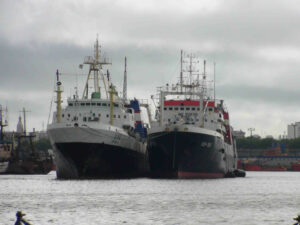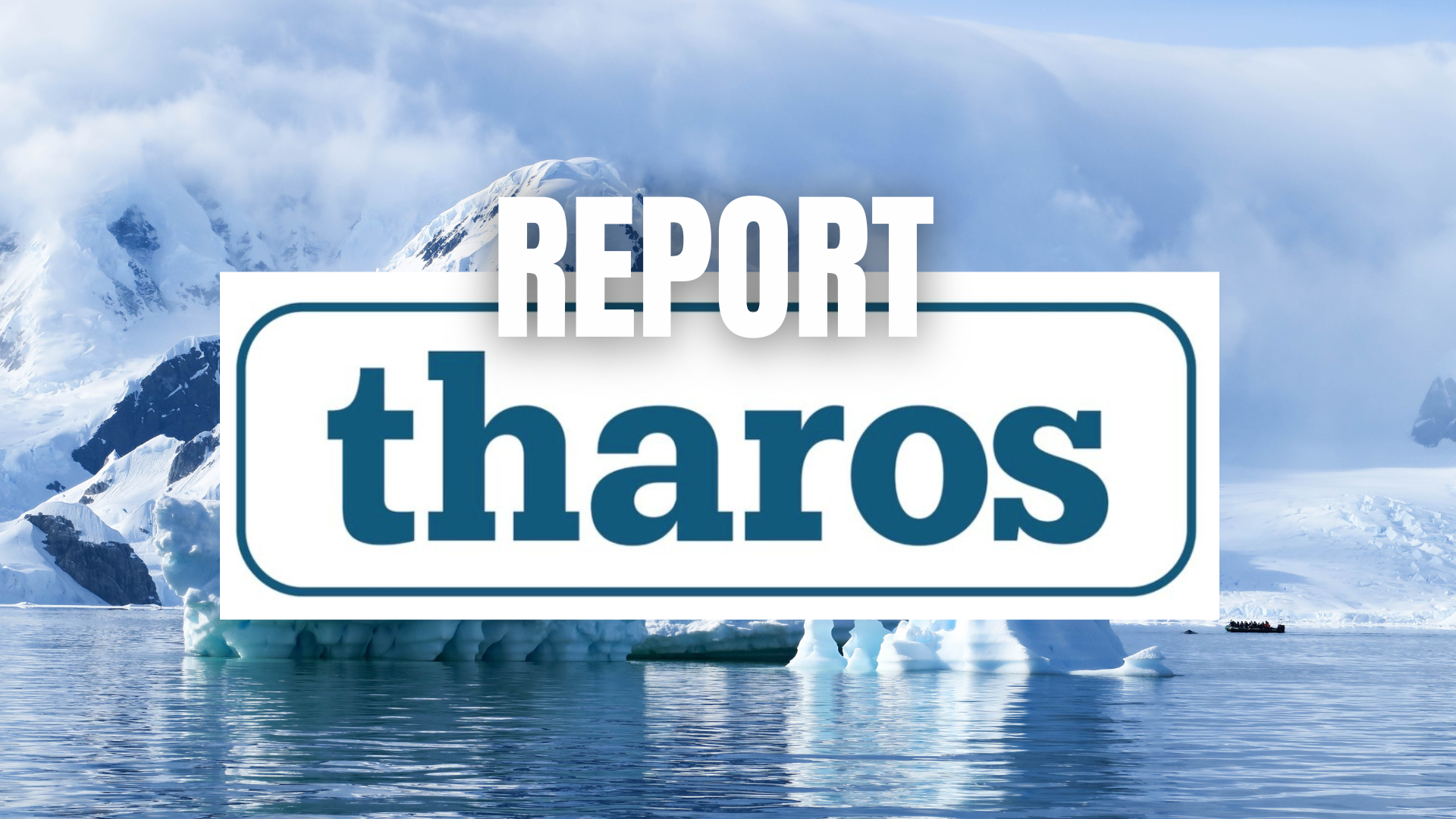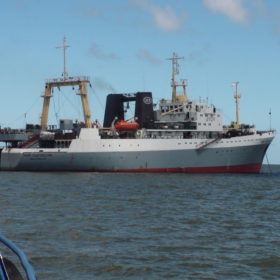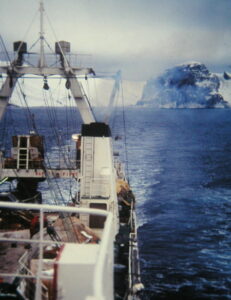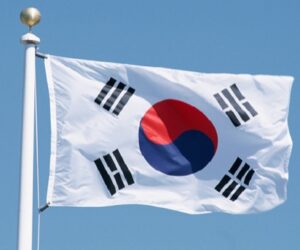|
Bangkok (Thailand) VICTAM Conference Speech (2008)  Exploratory fishing for Krill commenced in the early 1960s with catch levels being initially low. Since early 1970s, Krill catches rose steadily from 19 700 tons in 1973/1974 to a peak of 528 000 tons in 1981/1982, then declined sharply until 1983-1984. Annual catch has stabilized around 100.000 tons (annual average) per season for the last 10 years. Very recently there has been resurgence on interest in fishing Krill, with the entry of new operators coming from Russia and Norway. Antarctic Krill fishery will then soon face a new growth curve, at a much faster pace compared the last three-decades’ slow move from low-unit catch not-efficient operations to high-catch efficient high-yield operations. Although the 2007/08 South Antarctic Krill fishing season notifications add 754 000 tons, we expect a probable tonnage close to 260 000 tons, even much less if some of the new projects are further delayed. If this last figure prevails, the total Krill meal and oil supply will be approximately 30 400 and 730 tons, respectively, for the season 2007/2008. Exploratory fishing for Krill commenced in the early 1960s with catch levels being initially low. Since early 1970s, Krill catches rose steadily from 19 700 tons in 1973/1974 to a peak of 528 000 tons in 1981/1982, then declined sharply until 1983-1984. Annual catch has stabilized around 100.000 tons (annual average) per season for the last 10 years. Very recently there has been resurgence on interest in fishing Krill, with the entry of new operators coming from Russia and Norway. Antarctic Krill fishery will then soon face a new growth curve, at a much faster pace compared the last three-decades’ slow move from low-unit catch not-efficient operations to high-catch efficient high-yield operations. Although the 2007/08 South Antarctic Krill fishing season notifications add 754 000 tons, we expect a probable tonnage close to 260 000 tons, even much less if some of the new projects are further delayed. If this last figure prevails, the total Krill meal and oil supply will be approximately 30 400 and 730 tons, respectively, for the season 2007/2008. Within the 2000s, there has been a shift in the type of targeted end-products, in line with a higher demand of aqua-feed proteins, feed-bait grade whole raw frozen and the “wellness” industry claiming for nutraceutical end-products such as Omega 3. Simultaneously, the 2000s witnessed a change in the type fishing methods and on-board processing yields, change that has had a profound effect on the resulting volumes; from 2004/2005 to 2007/2008 seasons, feed-grade dried meal and whole raw frozen Krill have seen annual average production volumes of 9 000 and 65 000 tons, respectively, for a total capture estimate of 120 000 tons of raw Krill for the season 2006/2007. Nonetheless the current underserved demand for marine proteins and fats, we do not see feasible that dried Krill meal and liquid Krill oil undertake the lead as sustainable and price-affordable aqua-feed ingredients, among other factors, subject to fishing & environmental restrictions, low annual capture volumes, price considerations and trade-off products. If we assume, as a theoretical example only, that the 2007/2008 season 754 000 tons of Krill fishing requested permits are entirely used on area 48, it would exceed this area precautionary limit by at least 20% a situation we do not expect to happen. Nonetheless, we estimate that a probable approximately 260 000 tons will be captured within this 2007/2008 season (min 173 000 and max 291 000 ton), a volume that may grow up close to the precautionary limit within the coming 3 seasons (up to 2009/2010), depending on the fishing area. In the non-achievable and hypothetical scenario that the entire 6,5 Million TAC quota is processed as dried meal and oil only, using the actual average processing yields, it means approximately 1 100 000 tons of meal and 32 500 tons of feed-grade Krill oil supply per season. Comparatively, annual brown fishmeal and fish oil production is close to 6 000 000 and 1 000 000 tons, respectively. Pricing is another factor that may preclude Krill meal to become an affordable feed ingredient. Krill oil is a sort of new product, so there is not yet a well-known established price trend from where convenient price matrixes can be built. Regarding Krill meals, within the 1980s and part of the 1990s, ex-Japanese prices range from US$450 up to US$750 per ton FOB South American port, few qualities reaching US$975 per ton, while Japanese prices were twice as high, or even more, compared to these ones. Late 1990s and early 2000s, USA and Ukrainian Krill meals were able to match, sometimes even surpass Japanese quality meals through THAROS’ prices approaching US$1 350 up to US$1 550 per ton FOB South American port. We expect a higher supply competition forcing somehow prices to diminish within the coming 18-24 months, in line with a higher production base, overall demand-stagnation, vegetable protein supplementation and processing complexities. Tharos’ proprietary Krill meal price predictive model sees first-delivery Krill meal prices approximately 10-15% lower compared to actual prevailing highest prices. Other competing forces are also analyzed on this report. In respect to Krill oil, this past seasons’ situation are not enough to show us a clear path, nonetheless at present, feed-grade Krill oil price is found in the vicinity of US$7,5 per lt up to US$30 per lt, or higher, depending on quality and processing conditions, which might face an average price increase in the vicinity of 27 up to 32%, for oil made as a by-product from the regular dried meal processing line. Comparatively, pharma-grade oil prices we expect them to remain as high as it has been for the past few seasons, in a range of US$150 up to US$250 per lt FOB. If the use of Krill as a feed ingredient for the aquaculture industry was the 1990s motivation, Krill outstanding medical properties and its immense potential in the lucrative nutraceutical market becomes the 2000s driver. [protected] Protected files: South Antarctic Krill – Industry Overview – Contents.pdf South Antarctic Krill – Industry Overview – Final Version.pdf [/protected] |
